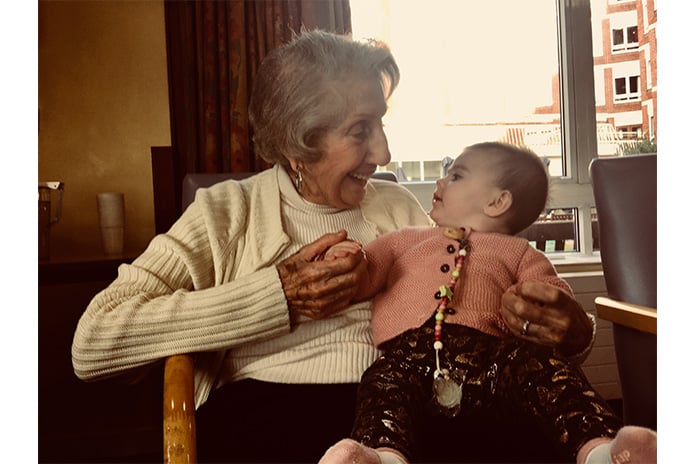A south-London nursery co-located with a residential care home is being hailed as a flagbearer for new models of learning and sharing across the generations
Words Libby Norman
When Apples and Honey Nightingale Nursery opened its doors last September at Nightingale House residential care home in Wandsworth, it attracted a shower of positive publicity as the UK’s first intergenerational nursery setting – young and old located together, sharing facilities and interacting on a daily basis. Stories appeared in specialist early years press, on national radio and TV and were also widely shared on social media. You can understand the flurry, for it’s hard not to conclude that this is one of those lightbulb ideas that could profoundly influence the future design of early years and residential care settings.
The nursery is a social enterprise that utilises space within an existing residential campus with beautiful grounds. Like Nightingale House, this is a Jewish faith-based setting but the nursery welcomes all children. It reserves 20 per cent of its place for the children of staff at Nightingale House and hosts a free baby and toddler group every week. This means local residents with very young children can share and socialise within a nurturing, well-equipped and intergenerational environment.
This is certainly not the first time care homes and nurseries have been co-located. Japan pioneered schemes in the 1970s; others have been built or are in planning across the Far East. There are co-located nurseries and care homes in Canada and the US, notably the much-lauded Providence Mount St Vincent intergenerational centre (known as The Mount) in Seattle. But Apples and Honey Nightingale remains unique in some respects. It was carefully designed from the outset as a planned meeting point and community hub of young and old and its social enterprise status places it at the heart of an urban village.

For Judith Ish-Horowicz MBE, co-founder of the nursery, it is much more than a social winner. It’s been a long-term vision that she describes it as her: “baby”. With a stellar career in teaching and early years, plus an MBE (2010) for Services to Early Years Education, this is her second nursery. The original Apples and Honey in Wimbledon opened in 1991 and is consistently rated outstanding by Ofsted; her track record with an exemplar early years setting helped when it came to convincing the powers that be of the merits of a new-style nursery setting. Co-founder Ali Somers has a Masters in Public and Nonprofit Management from New York University and special expertise in social enterprises, while head teacher Cindy Summer’s CV includes spells as director of Tiger Tots American Preschool in Taipei and head of Alyth Kindergarten in Temple Fortune, London. In other words, this is a team of very big hitters.
You may conclude they needed to be. Ofsted only issued first guidance on registering and inspecting co-located intergenerational care centres in mid April. Stephen Burke of think tank United for All Ages (he prefers the term ‘think and do tank’) campaigns for intergenerational environments – with a target of 500 intergenerational centres by 2022. He organised the April roundtable meeting that brought Ofsted and the CQI together with providers. Like everyone who has visited Apples and Honey Nightingale, he’s inspired by the environment, adding that while other nursery and care home sites are co-located, they are not sharing activities. He would like to see many more initiatives like this. He says: “In theory, every nursery could link up with its local care home”.
It is the integration at Apples and Honey Nightingale that has set policy makers, care providers and campaigners thinking. Activities here are part of the rhythm of the day. There are shared games, sing-songs, cooking lessons, storytelling sessions and celebrations of festivals. “We have planned intergenerational activities every day,” says Ish-Horowicz. She is careful to point out that this is managed carefully and respectfully – never forgetting that this is the residents’ home.

The outcome of these activities has been, says Ish-Horowicz, beneficial for young and old alike. “They really do interact beautifully.” Some Nightingale House residents have told her that being around the children has given them a reason to live, to try harder to exercise and keep up their energy levels. She says: “Many of the residents here haven’t, because of war or personal circumstances, had children. As we also have the baby and toddler group every week, they feel part of a wider community and can watch the children grow and develop week by week. Seeing a man in his 90s who never had children himself bottle feed a baby is something very special.”
Children’s families get involved too (Ish-Horowicz says the home has an amazing pool of volunteers). Birthday cards and presents get swapped and links are formed that benefit all generations. The children – many without grandparents nearby – form bonds with older people, also learning not to fear ageing or frailty or think it’s something weird. “It’s enriching for them and they develop a sense of their own place in the world – the cycle of life and chain of tradition.” She adds: “The children have become remarkably sensitive to the needs of older residents. They move and interact with them in a sensitive way”.
While many schools and nursery settings have a clear and laudable programme of intergenerational mixing, Apples and Honey Nightingale has taken things several steps further. Stephen Burke of United for All Ages suggests that this could be a model for the future.
“Children and residents benefit from the interaction and parents who visit the nursery become closely involved. The other beneficiaries are staff – care homes can feel quite closed and isolated from wider society. This opens them up as shared and social places.”






COMMENTS ARE OFF THIS POST